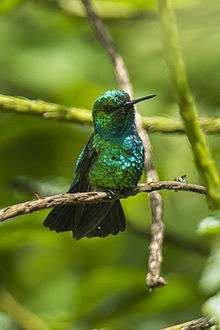Blue-tailed emerald
The blue-tailed emerald (Chlorostilbon mellisugus) is a hummingbird found in tropical and subtropical South America east of the Andes from Colombia east to the Guianas and Trinidad, and south to northern Bolivia and central Brazil.
| Blue-tailed emerald | |
|---|---|
 | |
| Scientific classification | |
| Kingdom: | Animalia |
| Phylum: | Chordata |
| Class: | Aves |
| Order: | Apodiformes |
| Family: | Trochilidae |
| Genus: | Chlorostilbon |
| Species: | C. mellisugus |
| Binomial name | |
| Chlorostilbon mellisugus | |
| Synonyms | |
|
Trochilus mellisugus Linnaeus, 1758 | |

The taxonomy is highly complex and it often includes C. canivetii, C. auriceps, C. forficatus, C. assimilis, C. gibsoni and C. melanorhynchus from north-western South America and Central America as subspecies.
It is a bird of savanna, scrub, cultivation and similar semi-open woodland. In the Amazon, where generally uncommon and more localized than in the northern part of its range, it mainly occurs at forest edge and in várzea. The female lays her eggs in a small cup nest, similar to that of the ruby-topaz hummingbird, placed on a horizontal tree branch. Incubation is 13 days with a further 18 days to fledging.
The blue-tailed emerald is 7.5 cm (3 in) long and weighs 2.6 g. The black bill is relatively short and straight. The male has a brilliant green plumage, with white thighs and a dark metallic blue tail (clearly forked in the northern part of its range; slightly so in the central and southern part). The female average smaller than the male and also differ by the grey-white underparts, a blackish ear patch, a short white supercilium/post-ocular streak and white-tipped outer tail feathers.
Blue-tailed emeralds feed on insects and nectar. The song is a pleasant twittering, and the call of this species is a pebbly tsip.
References
- BirdLife International (2017). "Chlorostilbon mellisugus". The IUCN Red List of Threatened Species. IUCN. 2017: e.T22687313A112399190. doi:10.2305/IUCN.UK.2017-1.RLTS.T22687313A112399190.en. Retrieved 13 January 2018.
- ffrench, Richard (1991). A Guide to the Birds of Trinidad and Tobago (2nd ed.). Comstock Publishing. ISBN 0-8014-9792-2.
- Hilty, Steven L (2003). Birds of Venezuela. London: Christopher Helm. ISBN 0-7136-6418-5.
